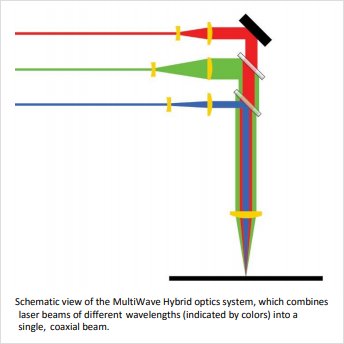Flexible Laser Manufacturing
Conventional laser cutting uses a single wavelength to cut through a specific, homogenous material. If that material is a composite, consisting of a matrix material and a reinforcing material, then using a single wavelength will not cut the material efficiently.
For example, a Carbon Fibre Reinforced Polymer (CFRP) consists of a polymer matrix material, reinforced with carbon fibre fabric. The polymer has a low vaporisation temperature and low thermal conductivity. The carbon fibre has a vaporisation temperature that is nearly an order of magnitude higher and very high thermal conductivity.
In terms of laser wavelength, the carbon fibre absorbs well across the visible and IR spectra. On the other hand, the polymer absorbs in the mid-IR range but is transmissive in the near-IR and visible range. This difference in both physical and optical properties means that a single laser wavelength would not be an optimal cutting solution – the power density needed to cut the carbon fibre would effectively lead to substantial degradation of the polymer.
Multiple Wavelength Laser Cutting
Our product partners, Universal Laser Systems, have developed multiple wavelength laser processing technology through their MultiWave Hybrid™ system. This allows laser beams of different wavelengths to be combined to form a single coaxial beam. Two or more lasers can be used simultaneously to cut a composite or laminated material.

For example, to cut a 1.0 mm thick CFRP sheet, a beam from a 75 watt CO² laser was combined with a beam from a 40 watt Yb-doped fiber laser. The Yb-doped laser vaporises the carbon fibre while the CO² laser ablates the polymer. This minimises damage to the polymer and because the two lasers are running simultaneously, allows the cutting speed to increase by a factor of two.
The MultiWave Hybrid™ process can efficiently cut a wide variety of composites including metal filled polymers, commonly used in EMI shields. As with the CFRP material, the CO² laser ablates the polymer while the Yb-doped laser vaporises the metal particles.
Sequential Processing
As well as combining laser beams, MultiWave Hybrid™ technology also allows each laser to be used independently. This enables sequential process steps that require different laser wavelengths to be completed in a seamless workflow.
For example, the manufacture of a flexible electronic circuit may require using three different laser wavelengths. In this instance, the starting point is a carbon ink screen that has been printed on a PET substrate. To create conductive circuit elements, the ink is selectively ablated from the PET using a 1.06µm Yb-doped laser. The PET substrate is then marked with a serial number using a 9.3 µm CO2 laser. This creates a strong mark because PET has a strong absorption peak at this wavelength. The final step is in cutting the circuit out from the PET using a 10.6µm CO² laser.
Flexibility Down the Line
Universal Laser’s MultiWave Hybrid™ laser processing technology enables flexible manufacturing in two ways. It allows laser beams with different wavelengths to be combined to form a single co-axial beam. This allows materials made of constituents with different physical and optical properties to be cut efficiently and simultaneously - preventing degradation, minimising scrap and increasing productivity. Alternatively, it can be used as part of a seamless workflow, allowing each laser to be used independently as part of a sequential process.
For further information on advances in Flexible Laser Manufacturing and details of Universal Laser’s MultiWave Hybrid™ systems and technology, please contact sales@tlm-laser.com